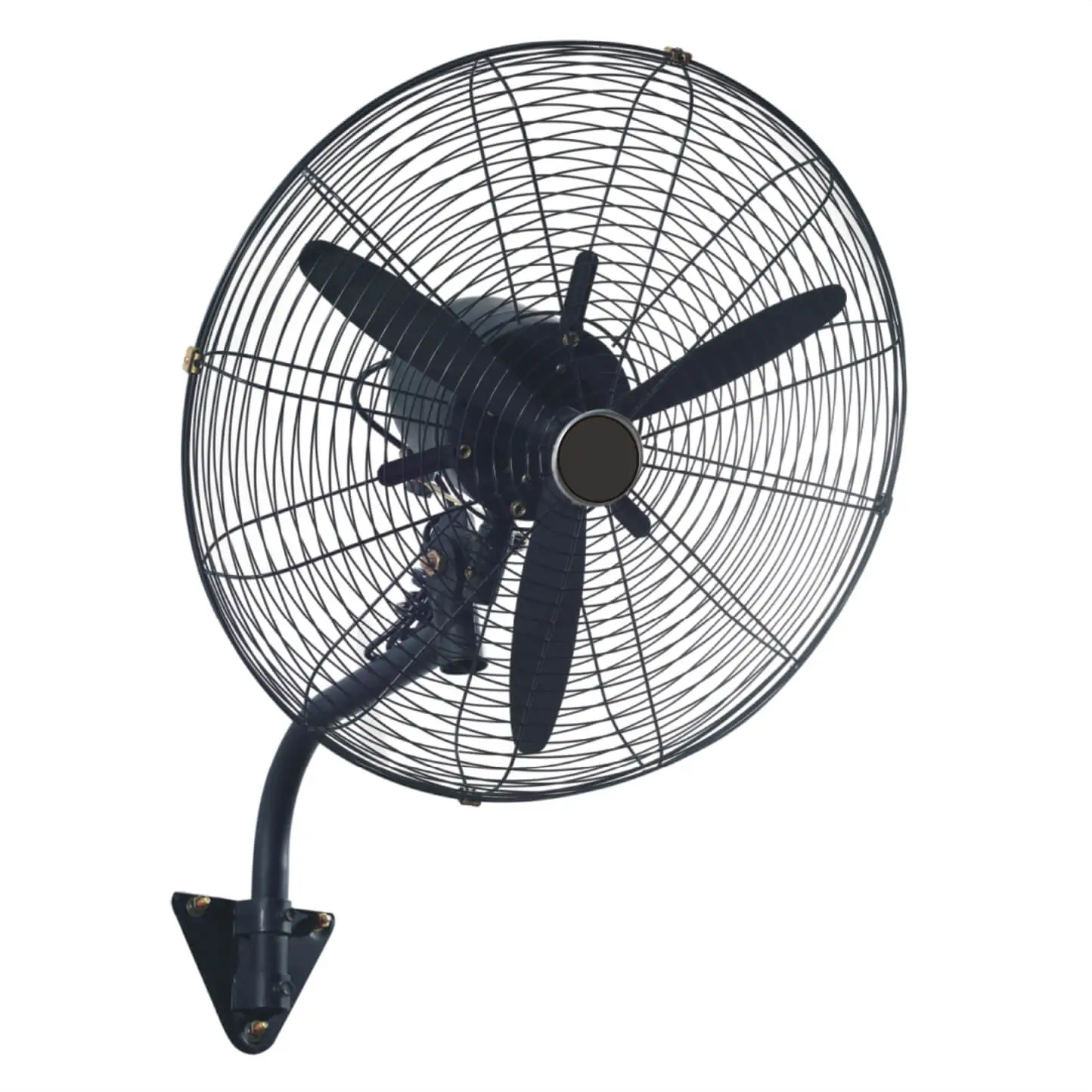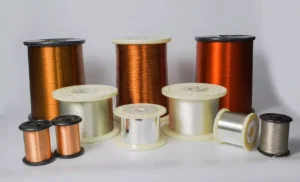Industrial fans are key for keeping large workspaces like factories and warehouses comfortable and safe.
They help circulate air, control temperature, and keep the air clean.
This guide will help you pick the right fan for your needs, focusing on their design, types, and how to choose one based on airflow, noise, and energy efficiency.
Introduction to Industrial Fans
Industrial fans are large, powerful fans designed for use in places like factories, warehouses, workshops, and manufacturing plants.
Their main job is to move and circulate air, helping to cool down these big spaces, remove unwanted smoke or smells, and ensure a constant supply of fresh air.
Built to be tough and durable, these fans can operate for long hours under tough conditions.
They play a crucial role in maintaining a comfortable and healthy work environment, aiding in temperature control and air quality improvement.
Whether it’s keeping workers cool or ensuring machinery operates within safe temperature ranges, industrial fans are vital in various industrial settings.
Industrial vs. General-Purpose Fans
When choosing between industrial and general-purpose fans, it’s important to understand the key differences that make each suitable for their intended environments.
Here’s a comparison that makes these distinctions clear:
| Feature | General-Purpose Fans | Industrial Fans |
|---|---|---|
| Material Gauges | Light gauge sheet metal and plastic. | 10 gauge to plate material. Cast aluminum and stainless steel construction available. |
| Construction | Tabs and lock seams. | Continuous welds. |
| Bearings | Sleeve or strap type. Short bearing life. | Ball or roller bearings in cast iron bearing housings. Much longer bearing life. |
| Motors | Light duty, sleeve bearings, no service factor, minimum design features. Open Drip Proof enclosure. | Continuous duty, ball bearings, with service factors, special design features, generally TEFC (Totally Enclosed Fan Cooled) or EXP (Explosion Proof) enclosures. |
| Safety Factors | Slower wheel and shaft speeds. | Much higher wheel and shaft speeds. |
| Air Flow | Generally limited to 2000 CFM or less. | From 200 to over 100,000 CFM. |
| Pressures | Generally 0.10″ to 4.0″ static pressures. | From 0.50″ to over 100″ static pressures. |
To wrap it up, general-purpose fans work well for easy jobs and small areas, but industrial fans are made tough for big places and hard work.
Knowing the difference helps you pick the best fan for keeping spaces cool, safe, and running smoothly.
Whether you need to move a lot of air or keep things going without a hitch, choosing the right fan makes all the difference.
Exploring Types of Industrial Fans
Industrial fans come in various shapes and sizes, each designed for different tasks and spaces. Here’s a look at some of the most common types you’ll find:
Industrial Drum Fans
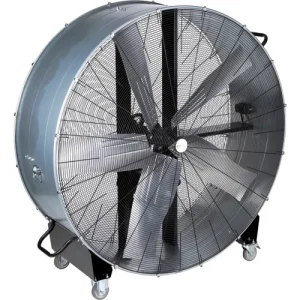
Portable and powerful, drum fans can quickly cool down specific areas or provide a fresh air supply.
Their high-speed airflow is especially useful for drying out spaces or providing relief in hot conditions.
Places to use: garages, workshops, and construction sites where temporary, powerful cooling is needed.
Industrial Wall Fans

Industrial wall fans save valuable floor space and can direct airflow precisely where it’s needed.
They often have swivel heads or oscillation features to cover a broader area effectively.
Places to use: small workshops, assembly lines, and animal barns where floor space is limited.
Industrial Pedestal Fans

Adjustable in height and tilt, industrial pedestal fans allow for targeted cooling.
Their mobility means you can move them to hot spots where cooling is needed most, like directly at workstations or over machinery that heats up.
Places to use: manufacturing plants, large office spaces, and outdoor events where adjustable, targeted airflow is beneficial.
Industrial Floor Fans

Floor fans sit directly on the ground and can be positioned to move air across the floor, drying it or pushing away debris.
They’re robust and straightforward, perfect for immediate, direct air movement.
Places to use: auto repair shops, gyms, workshops or construction sites, and any area needing quick drying or ventilation.
Commercial Misting Fans
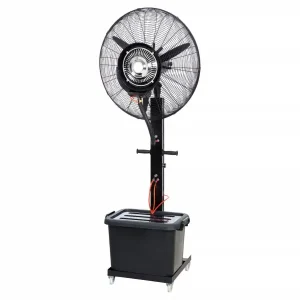
Misting fans cool the area by mixing air movement with a fine water mist.
The mist evaporates, cooling the air around it.
Ideal for places where traditional cooling methods aren’t possible, misting fans also add a bit of moisture to dry air, making the environment more comfortable.
Places to use: outdoor restaurants, theme parks, and sporting events where reducing ambient temperature makes a big difference in comfort.
Each type of fan offers unique features for different industrial environments, ensuring there’s a solution for almost any air movement or cooling challenge you might face.
Centrifugal Fans

Work by pulling air into the center of the fan and then pushing it out at a 90-degree angle.
This design allows them to create high-pressure airflow, making them ideal for situations where air needs to move through filters, air coolers, or long ducts.
Places to use: industrial HVAC systems, spray booths, and dust collection systems.
Axial Fans

These fans move air in a straight line from back to front.
Because of their design, they’re great at moving a large volume of air at a low pressure, which is perfect for cooling large, open areas.
Places to use: warehouses, gymnasiums, and manufacturing floors where direct, linear airflow is needed.
Mixed Flow Fans

Combine the qualities of axial and centrifugal fans, pulling air in like an axial fan but then expelling it out the sides like a centrifugal fan.
This gives them the ability to move air efficiently over medium distances with a moderate pressure increase.
Places to use: parking garages, agricultural facilities, and commercial kitchens.
Inline Fans

Installed within the ductwork, they help boost airflow in specific sections.
Their placement means they’re out of the way and quiet, ideal for targeted ventilation in complex systems or tight spaces.
Places to use: growing rooms, server rooms, and bathroom ventilation in commercial buildings.
Industrial Ceiling Fans
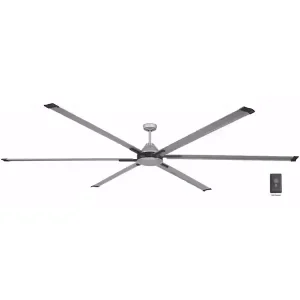
These big fans circulate a lot of air slowly, covering a wide area.
They’re designed to work without causing a strong breeze, making the air in large spaces like warehouses feel cooler without blowing papers away.
Places to use: big warehouses, assembly halls, and large indoor arenas.
Selecting the Right Industrial Fan
Selecting the right industrial fan involves understanding your specific needs and the unique characteristics of your space.
Here’s a breakdown of key factors to consider when choosing an industrial fan, ensuring you make an informed decision that maximizes efficiency, comfort, and safety.
Understanding Your Space and Needs
Know Your Space
- Look at Your Space: Notice if things like machines or shelves might block air. Fans that can go up high (like ceiling or wall-mounted fans), can help air move better around these blocks.
- Air Movement: See where air doesn’t move well or gets too hot. Knowing this helps pick a fan that can fix these issues, like pushing air where it’s needed.
- Fresh Air vs. Bad Air Out: If you need to get rid of bad air or bring in fresh air, consider fans that can be integrated into your ventilation system, like inline or axial fans.
Practical Use Case Considerations
- Cooling Workers vs. Equipment: The type of cooling needed may affect your choice. Pedestal fans are great for directing airflow at worker level, while drum or floor fans might be better for cooling equipment or drying floors.
- Fixing Specific Problems: For smoke or dust, look for fans designed for exhaust or with filters. For hot outdoor areas, misting fans can cool the air and keep dust down.
Where Your Fan Will Work
- Inside or Outside: Outside fans need to be tough for the weather. Inside fans can be chosen for how well they move air and how loud they are.
- Dangerous Spots: In places where there’s a risk of fires from gases or dust, you need fans that are made safe for these spots. Look for fans labeled “explosion-proof” because they’re built to not spark a fire. These fans are specially designed to be used safely in places where there might be flammable fumes or dust. Always make sure the fan you choose matches the specific safety requirements for your area to keep everyone safe.
- Wet or Dusty: In very wet places, fans that don’t mind getting wet work best. In dusty spots, pick fans that are easy to clean or keep dust out.
Picking a Fan for Your Space Size
- Big Rooms: Larger volumes and higher ceilings require fans with a higher CFM rating to move air effectively throughout the space. HVLS (High Volume, Low Speed) ceiling fans are excellent for very large spaces.
- Small or Tight Spaces: For smaller places, fans that you can move or point in certain directions, like pedestal or wall-mounted models, are better. They won’t take up much room and can still move air where you need it.
Airflow Requirements
Figuring Out How Much Air You Need to Move
- Calculate Your Space Size: First, you need to know how big your space is. Measure the length, width, and height of the room or area. Multiply these together to get the volume in cubic feet.
- Think About Air Changes: Decide how often you want all the air in the space to be replaced in an hour. This is called Air Changes per Hour (ACH). For example, a busy workshop might need the air to be changed more often than a storage room.
- Do the Math: To figure out how much air the fan needs to move, multiply the volume of your space by the ACH (Air Changes per Hour). This gives you the Cubic Feet per Minute (CFM) you need. For instance, if your shop is 10,000 cubic feet and you want the air to change 6 times an hour, you need a fan that can move 60,000 cubic feet of air per hour.
Considering Airflow Direction and Speed
- Where Does the Air Need to Go?: Think about if you need to move air across the room, down to the floor, or up towards the ceiling. This helps you choose a fan that can point the air in the right direction.
- How Fast Should the Air Move?: In some places, you might want a gentle breeze, while in others, you might need a strong blast of air. Fans come with different speed settings, so pick one that can go fast or slow depending on what you need.
Making Sure the Fan Fits Your Airflow Needs
Match the Fan to Your CFM Calculation
Look for a fan that has the CFM rating you calculated or higher.
You can check the fan’s package or manual for its CFM rating.
Many fans will list this number clearly.
If you’ve done your calculation and know the CFM you need, compare it to what’s on the box.
Choose a fan with a CFM rating at or above your requirement to ensure it can handle the air volume in your space.
If you’re unsure or the information isn’t readily available, don’t hesitate to ask a store associate for help or look up the model online for more details.
This ensures the fan can handle the air volume in your space.
Choose Adjustable Fans for Flexibility
Fans with variable speed settings or adjustable directions give you more control over airflow, making it easier to keep the air moving just right no matter what you’re doing.
Noise Considerations
When picking out an industrial fan, it’s important to think about how loud it will be.
Here’s how to make sure you get a fan that won’t be too noisy for your space:
- Check the Noise Level: Look for the decibel (dB) rating on the fan’s packaging or in the manual. This number tells you how loud the fan is. A lower dB rating means a quieter fan.
- Consider Where the Fan Will Be Used: If the fan is going near people, like in a workspace or public area, you’ll want a quieter fan. In places where noise isn’t a big deal, like an empty warehouse, you might be okay with a louder fan.
- Look for Quiet Features: Some fans are designed to be quieter. They might have special blades that cut through the air smoothly or motors that run quietly. If noise is a big concern, look for these features.
- Think About Fan Size and Speed: Bigger fans or those that run faster can be louder. Sometimes, using a couple of smaller fans instead of one big one can keep things quieter while still moving a lot of air.
- Adjustable Speeds Can Help: A fan with adjustable speeds can be turned down to reduce noise when you don’t need as much air movement. This flexibility can be really handy.
Sometimes a little bit of noise might be worth it if the fan does a great job of keeping your space cool and comfortable.
But by paying attention to the points above, you can choose a fan that keeps the noise at a level that’s right for you.
Energy Efficiency and Operational Cost
When choosing an industrial fan, considering energy efficiency and operational costs can lead to significant savings and environmental benefits over time.
Here’s how to ensure you select a fan that aligns with these priorities:
- Look for Energy-Efficient Models: Fans with energy-efficient motors or those labeled as ENERGY STAR-rated use less power, which can lower your electricity bills. These models are designed to deliver the same performance while consuming less energy.
- Check for Variable Speed Options: Fans that offer variable speed settings allow you to adjust the airflow according to your needs. This means you can lower the speed to save energy during cooler times or when less ventilation is needed, reducing overall power consumption.
- Consider the Fan’s Size and Efficiency: Bigger isn’t always better. Choose a fan size that’s appropriate for your space. An oversized fan consumes more energy without providing additional benefits, while an undersized fan might run continuously without effectively cooling or ventilating the area.
- Assess Long-Term Costs: While energy-efficient fans might come with a higher upfront cost, their lower operational costs can save you money in the long run. Calculate the potential energy savings over the fan’s lifespan to determine if it’s a cost-effective choice.
- Maintenance and Durability: Fans that are built to last and require less maintenance contribute to lower operational costs. Durable materials and quality construction mean fewer replacements and repairs. Regular maintenance can also ensure the fan operates efficiently, prolonging its lifespan and maximizing your investment.
By prioritizing energy efficiency and operational cost in your selection process, you not only reduce the environmental impact of your industrial fan but also enjoy ongoing savings, making it a smart and sustainable choice for your business or workspace.
Safety and Additional Features
Considering safety and additional features is crucial when selecting an industrial fan, as these factors can significantly enhance usability and ensure a secure environment.
Here’s a closer look at what to keep in mind:
Safety Considerations
- Explosion-Proof Fans: In environments with flammable gases or dust, choose explosion-proof fans. These are designed to prevent ignition, offering extra safety in potentially hazardous areas.
- Overload Protection: Fans with built-in overload protection can prevent motor damage and reduce fire risk by automatically shutting off if they’re working too hard.
- Guarded Blades: Ensure the fan has sturdy guards to protect users from moving parts. This is especially important in spaces where people are moving around or working close to the fan.
- Certifications and Standards: Look for fans that meet relevant safety standards and certifications for your industry. This can include OSHA compliance, UL listing, or specific certifications for hazardous locations.
Additional Features
- Adjustable Height and Tilt: Fans with adjustable height and tilt angles provide flexibility, allowing you to direct airflow exactly where it’s needed for maximum comfort and efficiency.
- Remote Control and Timers: Some fans come with remote controls and timers, making it easier to adjust settings without having to manually interact with the fan. This can be particularly useful in busy or hard-to-reach areas.
- Oscillation: An oscillation feature can help distribute air more evenly throughout a space, preventing hot spots and ensuring consistent comfort for everyone.
- Portability: Fans designed for easy movement, equipped with wheels or lightweight construction, can be quickly relocated to where they’re needed most, offering versatile cooling solutions across various settings.
- Noise Reduction Technology: Advanced fans may incorporate technology or design elements that minimize noise, making them suitable for quieter environments or spaces where noise could be disruptive.
By prioritizing safety and considering additional features that enhance functionality and convenience, you can select an industrial fan that not only meets your air circulation needs but also contributes to a safer, more comfortable, and efficient environment.
Conclusion
Choosing the right industrial fan means looking at how big your space is, what you need the fan for, and where it’s going to go.
You want a fan that moves enough air (CFM), isn’t too loud, saves energy, and won’t cost too much over time.
Make sure it’s safe, especially in places where there might be fire risks.
Look for handy features like being able to change the speed, move the fan easily, or control it from afar.
Picking the right fan helps keep your space cool, safe, and comfy while saving you money and trouble.
FAQ
Can I use an industrial fan in a residential setting?
Yes, but consider the fan’s size and noise level to ensure it’s suitable for your home environment.
Industrial fans are powerful and might be too intense for small rooms.
How do I protect my industrial fan from rusting if used outdoors?
Look for fans made with rust-resistant materials or coatings, especially if you plan to use them in humid or outdoor environments.
What’s the best way to clean an industrial fan?
Turn off and unplug the fan first. Use a soft cloth to wipe down the exterior and blades.
For tougher grime, a mild soap solution can be used, but avoid getting motor parts wet.
Can industrial fans help with pest control in open areas?
Yes, the airflow from a powerful fan can deter flying insects from patios and dining areas, making outdoor spaces more comfortable.
Is it better to have multiple small fans or one large industrial fan?
It depends on your space and needs.
Multiple small fans can offer flexible positioning, while one large fan might provide more uniform air circulation in a large area.
What safety features should I look for in an industrial fan for a workshop?
Ensure the fan has sturdy guards, secure mounting options, and if necessary, explosion-proof ratings for working with flammable materials.
